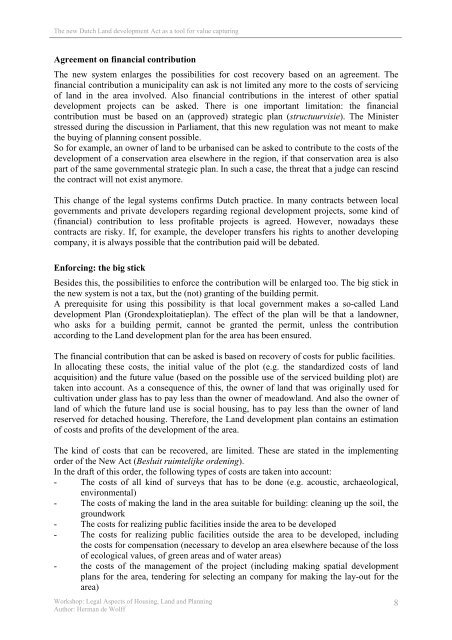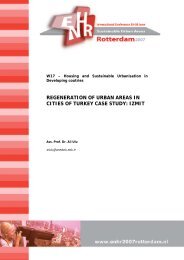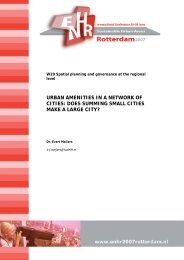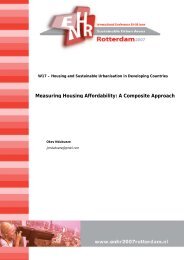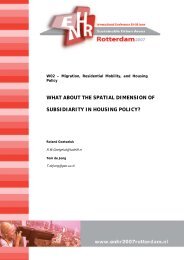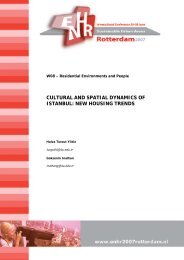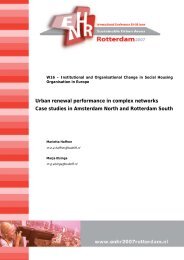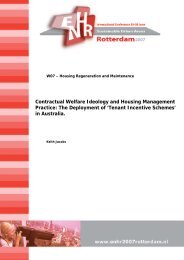The new Dutch Land development Act as a tool for value capturing
The new Dutch Land development Act as a tool for value capturing
The new Dutch Land development Act as a tool for value capturing
Create successful ePaper yourself
Turn your PDF publications into a flip-book with our unique Google optimized e-Paper software.
<strong>The</strong> <strong>new</strong> <strong>Dutch</strong> <strong>Land</strong> <strong>development</strong> <strong>Act</strong> <strong>as</strong> a <strong>tool</strong> <strong>for</strong> <strong>value</strong> <strong>capturing</strong><br />
Agreement on financial contribution<br />
<strong>The</strong> <strong>new</strong> system enlarges the possibilities <strong>for</strong> cost recovery b<strong>as</strong>ed on an agreement. <strong>The</strong><br />
financial contribution a municipality can <strong>as</strong>k is not limited any more to the costs of servicing<br />
of land in the area involved. Also financial contributions in the interest of other spatial<br />
<strong>development</strong> projects can be <strong>as</strong>ked. <strong>The</strong>re is one important limitation: the financial<br />
contribution must be b<strong>as</strong>ed on an (approved) strategic plan (structuurvisie). <strong>The</strong> Minister<br />
stressed during the discussion in Parliament, that this <strong>new</strong> regulation w<strong>as</strong> not meant to make<br />
the buying of planning consent possible.<br />
So <strong>for</strong> example, an owner of land to be urbanised can be <strong>as</strong>ked to contribute to the costs of the<br />
<strong>development</strong> of a conservation area elsewhere in the region, if that conservation area is also<br />
part of the same governmental strategic plan. In such a c<strong>as</strong>e, the threat that a judge can rescind<br />
the contract will not exist anymore.<br />
This change of the legal systems confirms <strong>Dutch</strong> practice. In many contracts between local<br />
governments and private developers regarding regional <strong>development</strong> projects, some kind of<br />
(financial) contribution to less profitable projects is agreed. However, nowadays these<br />
contracts are risky. If, <strong>for</strong> example, the developer transfers his rights to another developing<br />
company, it is always possible that the contribution paid will be debated.<br />
En<strong>for</strong>cing: the big stick<br />
Besides this, the possibilities to en<strong>for</strong>ce the contribution will be enlarged too. <strong>The</strong> big stick in<br />
the <strong>new</strong> system is not a tax, but the (not) granting of the building permit.<br />
A prerequisite <strong>for</strong> using this possibility is that local government makes a so-called <strong>Land</strong><br />
<strong>development</strong> Plan (Grondexploitatieplan). <strong>The</strong> effect of the plan will be that a landowner,<br />
who <strong>as</strong>ks <strong>for</strong> a building permit, cannot be granted the permit, unless the contribution<br />
according to the <strong>Land</strong> <strong>development</strong> plan <strong>for</strong> the area h<strong>as</strong> been ensured.<br />
<strong>The</strong> financial contribution that can be <strong>as</strong>ked is b<strong>as</strong>ed on recovery of costs <strong>for</strong> public facilities.<br />
In allocating these costs, the initial <strong>value</strong> of the plot (e.g. the standardized costs of land<br />
acquisition) and the future <strong>value</strong> (b<strong>as</strong>ed on the possible use of the serviced building plot) are<br />
taken into account. As a consequence of this, the owner of land that w<strong>as</strong> originally used <strong>for</strong><br />
cultivation under gl<strong>as</strong>s h<strong>as</strong> to pay less than the owner of meadowland. And also the owner of<br />
land of which the future land use is social housing, h<strong>as</strong> to pay less than the owner of land<br />
reserved <strong>for</strong> detached housing. <strong>The</strong>re<strong>for</strong>e, the <strong>Land</strong> <strong>development</strong> plan contains an estimation<br />
of costs and profits of the <strong>development</strong> of the area.<br />
<strong>The</strong> kind of costs that can be recovered, are limited. <strong>The</strong>se are stated in the implementing<br />
order of the New <strong>Act</strong> (Besluit ruimtelijke ordening).<br />
In the draft of this order, the following types of costs are taken into account:<br />
- <strong>The</strong> costs of all kind of surveys that h<strong>as</strong> to be done (e.g. acoustic, archaeological,<br />
environmental)<br />
- <strong>The</strong> costs of making the land in the area suitable <strong>for</strong> building: cleaning up the soil, the<br />
groundwork<br />
- <strong>The</strong> costs <strong>for</strong> realizing public facilities inside the area to be developed<br />
- <strong>The</strong> costs <strong>for</strong> realizing public facilities outside the area to be developed, including<br />
the costs <strong>for</strong> compensation (necessary to develop an area elsewhere because of the loss<br />
of ecological <strong>value</strong>s, of green are<strong>as</strong> and of water are<strong>as</strong>)<br />
- the costs of the management of the project (including making spatial <strong>development</strong><br />
plans <strong>for</strong> the area, tendering <strong>for</strong> selecting an company <strong>for</strong> making the lay-out <strong>for</strong> the<br />
area)<br />
Workshop: Legal Aspects of Housing, <strong>Land</strong> and Planning<br />
Author: Herman de Wolff<br />
8


